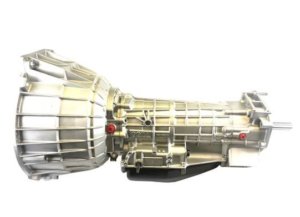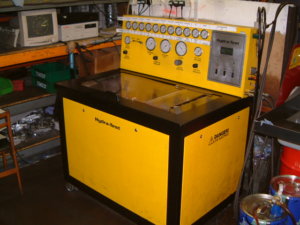ZF4HP22/24EH
(View Product)
-
FAQs
What oil temperature should my ZF be running at ?
There is a good guide to oil temps here
I can pull off in position 1 on the shifter and reverse is OK but in 'D' it will either not pull off or will crawl off in 3rd, why?
One of the internal one way clutches has failed which means that when you try to pull off in 'D' it slips for a few seconds before the ECU recognises a fault then the ECU puts it into 'limp home' which is 3rd gear, then it pulls off, its not easy to just charge this part so usually the whole box is replaced, note this fault can be caused if the chain in the transfer case is jumping.
I have just removed the LT230 from my ZF autobox and the output shaft seems very loose, is this normal ?
yes, there is no rear bearing as the shaft is supported in the transfer case input gear.
What is the oil capacity of the ZF 4HP22 ?
Oil change approx 5 LitresDry fill approx 9 Litres
My D2 / P38 is shifting late, I have to rev a lot before it changes gear,
If the engine air flow meter is giving incorrect data to the autobox ECU this can cause late shifting, try another air flow meter. Note on a tuned TD5 the stock converter will allow the engine to rev at a higher rpm, this is a different issue, see the TD5 HD converter section.
Whats the oil fill proceedure if the autobox is the later type sump with no dipstick ?
Remove the plug in the front face of the sump, fill with oil until it overflows, start the engine then pump fast to replenish the oil as it will be sucked into the autobox, fill until it overflows again, when it overflows, move the shifter through each position to get any air out. put the plug in. road test and recheck.
The flexplates on my Td5 keep breaking. Why?
This is usually caused be mis-alignment between the engine and the gearbox. Check all your dowels are present and correctly located.
Where is the Ashcroft Rebuilt number located on the autobox ?
Please see this photo to show the location of our RB number. It will be one letter and four numbers. i.e. D4567
My ZF 4HP22/24 autobox has a delay when taking up drive once stood overnight, why?
This is usually due to a worn oil pump housing, the wear results in reduced suction so it can take some time to prime and then get the oil pressure up.
-
Technical
A common problem with all ZF 4HP22/24 boxes is the failure of the oneway 'sprag' clutch. Once the cams in this one way sprag clutch 'flip' the unit will slip both ways resulting in the vehicle only pulling off with the shifter in position '1' not 'D' and driving OK when shifted up to position 2,3 and D until you stop then you need to pull it back to '1' to start off again. It is not feasible to change this unit in each rebuild as this one part is approx £ 400. By disassembling the 'sealed unit' we were able to examine the profile of the cams and understand how they work, from here the challenge was to find another cam from another type of autobox that would fit and had the correct profile to make the unit stronger by not allowing the cams to flip. After quite a lot of searching we found one, 're-cammed' some of these clutches and thoroughly tested them, we have not had one fail since. This is an example of how we are able to use our engineering background to understand a problem and cost effectively make the unit stronger without having to raise our prices.
We have also invested £ 20,000 in a test machine. This machine allows us to do 2 things. Firstly once the valve body has been rebuilt we are able to fit it to a plate on the test rig and run the valve body through its cycle with 45 deg pre-heated oil to simulate as close as we can get 'real world conditions' The hydraulic valve bodies are run through manually by winding a valve to simulate the governor increasing in speed and various pressure gauges are monitored to see that the valve body is applying the correct clutches at the correct pressures. When testing the electronic ZF valve bodies once the solenoids are all tested this cycling procedure can initially be run through manually to check all is well then the computer can run up to 100 full run cycles going from 1st, 2nd, 3rd, 4th and lock up down to 1st again to ensure no valve are sticking and the solenoids are not failing when hot and working hard.
We are also able to fit a test plate to the autobox in place of the valve body and apply heated oil at pressure to check we have no leakage or pressure drop on any of the clutch packs.
This machine has enabled us to improve the quality of our boxes by identifying any potential faults or problems before the box reaches the customer.
Please see a video below of a ZF4HP22 Electronic Valve Body being tested:
[embed]https://www.youtube.com/shorts/JHQ2Y_jAp9U[/embed]
-
Installation
Check List for fitting ZF Autobox
Please note that a good 50% of our 'warranty returns' are due to two basis installation errors.
1)debris and contamination in the oil cooler and oil cooler lines, even if you have flushed them out this is no guarantee they are clean, if the old box has suffered a bad failure you would be wise to replace these.
2)broken oil pump, by not fitting the torque converter correctly, read below.
Assembly
Check engine to bellhousing and Autobox to transfer case dowels are all fitted.
It is very important that you locate and install your torque converter correctly. One of the most common causes of failure is the torque converter not being located correctly onto the pump before fitting causing the pump to be broken on start up.
To avoid this we would suggest that you stand the autobox upright and lower the torque converter into the bellhousing.
When the torque converter has fully located onto the pump it is essential to then measure the distance from the bellhousing front face to the torque converter feet ( also known as the flange that the flexplate is bolted to).
Once the torque converter is inserted and checked make sure it does not fall forward when offering the autobox up to the engine. Do not be tempted to pull the gearbox into position with the bellhousing bolts, it should fully locate on the engine with no gap between the bellhousing and engine block.
With the autobox fitted to the engine, check that the converter will rotate freely and has a small amount (about 2mm) of end float. Bolt the converter to the flex plate using loctite or similar on the thread of the bolts.
Ensure the breather vents well away from the exhaust.
Oil Fill
Always use a good quality oil, preferably a Dextron III or similar. Put the transfer case in neutral and fill. Start the engine, the oil level will drop immediately, top back up straight away. Move the shifter lever up and down through the gears slowly whilst checking the oil level and topping up as required. Once the level has stabilised, put the transfer case in gear and the unit should now be picking up drive, this is indicated by the engine revs dropping when put in Drive.
non dipstick type autoboxes, TD5 Etc :
put transfer case in neutral remove oil filler level plug, front face of oil sump, fill until it overflows, start engine, quickly pump more oil in until it overflows move the gear stick up and down a few seconds in each gear whilst topping the oil level up, once level has stabilised, test drive and recheck oil level,
Set up
If the vehicle is a Disco I or Range Rover Classic under no circumstances drive with the kickdown cable disconnected, as this will cause premature autobox failure.
Ensure that the shift assembly is set correctly and full travel of the shifter and engagement of all gears is positive, partial shift will cause premature autobox failure.
If the vehicle is a Disco I or Range Rover Classic you may want to adjust the kickdown cable if you want to fine tune the shift pattern, the looser the cable the softer and earlier the shifts, the tighter the cable, the harder and later the shifts.
Torque Converter Depth Table
The box code is the last 3 digits of the second number down on the name plate on the left hand side of the autobox.
Box Code Depth in mm Box Code Depth in mm
061 22 747 27
064 22 748 18
065 27 757 27
332 51 759 27
593 51 763 83
699 51 764 27
631 51 765 27
727 27 766 96*
728 83 767 27
740 51 768 83
741 51 769 83
742 51 773 96*
744 18
*Note this is the depth for the standard converter.
If fitting our HD Td5 Converter please note the following instructions: -
The depth is 73.
The stock TD5 converter has 3 bolts, the new one has 4; the 4 bolts sit in a different place and it’s a little harder to access the new bolts. We can supply a couple of parts to assist you, see related parts below and you will also need a ratchet spanner to fit the 4 converter bolts but to hold the bolts in place and create friction for the ratchet to click you will need to drill a hole in the bellhousing and use some long nose pliers to hold the bolt in place whilst you tighten it with the spanner through the normal lower access hole. There is a link on our website to a template so you know where to drill the hole.
The two tools you may require are:
1) 28mm dia hole saw, available on our website
2) 13mm ratchet spanner, available on our website
Please note this is only recommended on a tuned TD5 engine. If you put this on a stock TD5 engine it will be detrimental as the engine will not have enough power to get up to enough revs for the turbo to start working due to the lower stall speed, this results in the engine 'bogging down' at say 2000 rpm and very poor acceleration.
Please call if you have any other queries.


